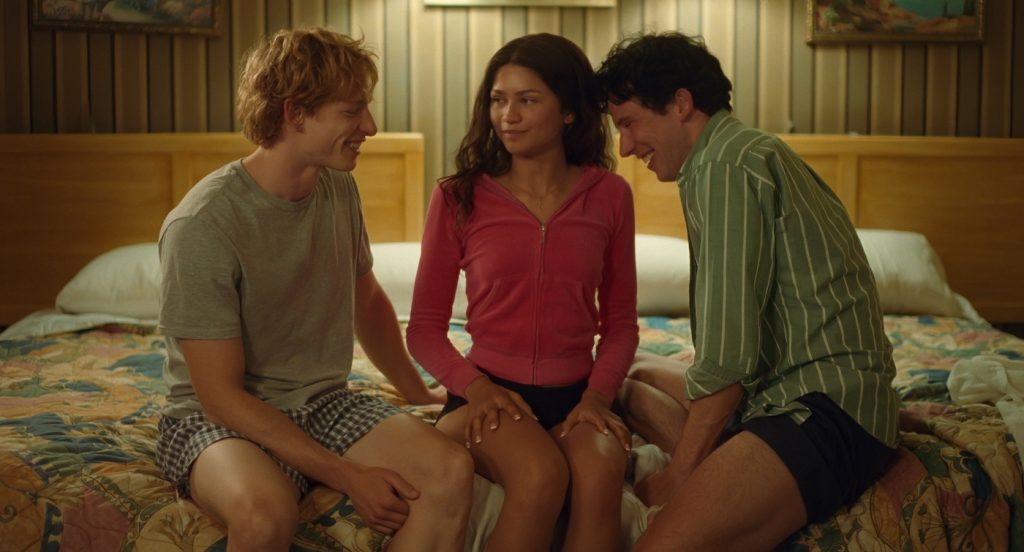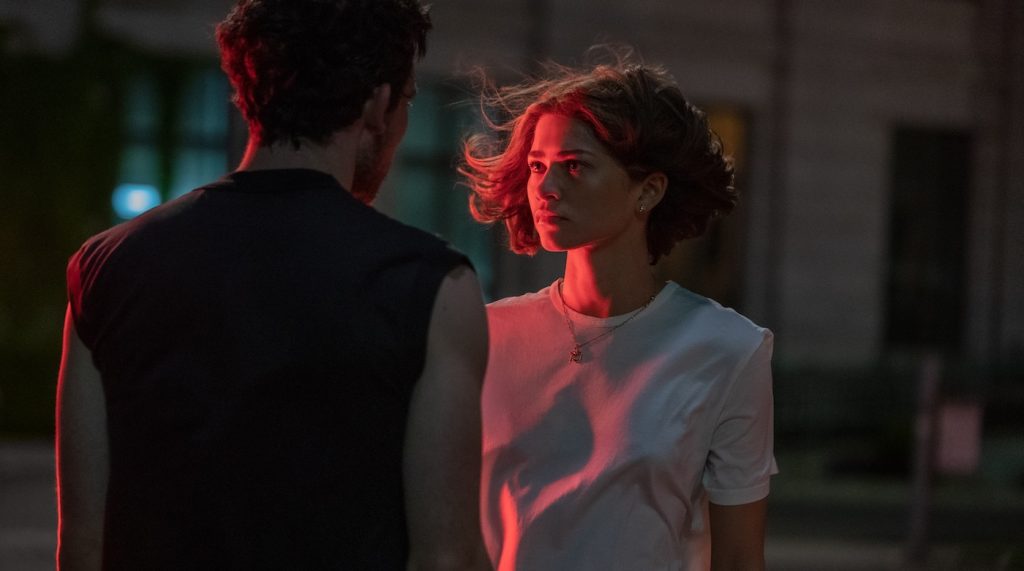“Challengers” Production Designer Merissa Lombardo Sets the Stage on Court & Off
Director Luca Guadagnino’s sexy new tennis romance, Challengers, layers a years-long love triangle of three millennial-era players over the highs and lows of their careers. At the center is talented, driven, and stunning Tashi (Zendaya). She first dates Patrick (Josh O’Connor), who plays as well as she does, but doesn’t take his career or their relationship seriously enough for either to work out. After getting knocked out of the circuit with a knee injury, Tashi gets together with Art (Mike Faist), a more earnest character with a more mediocre tennis game who Tashi, as his coach, manages to transform into a star.
Cutting across different chronologies, Tashi and Art live on the road in five-star hotels (one of Challengers’ shooting locations was the Newbury Boston) and, for years, have little to do with Patrick, who plays a journeyman’s game and lives out of his car. When Art hits an unusual career low, Tashi enters him as a wildcard in a low-level local challengers match with the aim of getting him an easy, ego-boosting win before a more important match. But Patrick is there too (sleeping in his car, in the club parking lot), desperate to win any part of the purse attached to the match. Once Tashi and Art arrive, he reconfigures his goals for something loftier.
On the court, Challengers gets everything right, from period-correct Adidas branding to the kinesio tape running up Art’s back. Off-court, the film keeps to Guadagnino’s predilection for elegant, unfussy interiors, whether it’s an airy Stanford dining hall or a high-end hotel bar Patrick can’t afford. For production designer Merissa Lombardo (I’m Thinking of Ending Things, Three Billboards Outside Ebbing, Missouri), it was important to offer both an accurate and a stylized view of the settings associated with competitive tennis, which meant building out almost the entire set of the pivotal challengers match and redoing well-known courts along the way.
We spoke with Lombardo about getting into the tennis circuit, scouting for Guadagnino-esque interiors around Boston, and building the three main characters’ visual backstories despite none of them having a home.
Was competitive tennis something you were familiar with going into the project?
No, not at all. In fact, when I got the script, I knew it would be a challenge, with no pun intended, to start researching this film and how to make it look interesting and not like a regular sports film. That was very important to me, and I think to Luca. We worked with Brad Gilbert and other consultants and experts to understand tennis, but from a design perspective, it was also important to see how tennis has been photographed, how it’s looked historically, and how we could bring a lot of that into our world.
That world alternates between realistic and stylized. How did you decide which direction to take each setting?
In the original script, there were so many different matches. I started from the point of, What do these things look like in real life? That’s a base, and from there, we play with colors, lines, simple graphics, even the clothing, and how that’s going to look on top of these big color walls. Everything was very intentional. We started from the point of reality and research and then, from there, tried to figure out how we could add our own look to things and make them look really graphic and beautiful. I’m glad you noticed that because in every different match, we tried to get color in that way because when you watch the games, you really do just see these individual people on this big color field, which is how I started looking at the world.
How did the production design support the arc of the characters growing up and changing?
We looked a lot at how actual tennis players live. There are a lot of grand hotel rooms, branding, and products, and we wanted to really show that. A lot of the films and projects I do have very character-heavy environments, but with these particular characters, you don’t know where they live. They kind of exist as they are, so for me, the question was, how do we represent these three different people? For example, we painted Patrick’s car interior, and we really thought about what was in there. And there are each of the hotel rooms as they progress in their careers. They obviously start in a dingy hotel room, which we built on a stage, and progress into more glamorous, beautiful rooms full of branding and products, all these things that are part of this lifestyle. I’m happy that people seem to be picking up on the fact that we were able to show progression and give the characters a visual backstory. I think the biggest progression was the party they went to after the Billie Jean King match. That was the first time we were using Adidas posters — this was the first entrance into that world.
There are also interior elements that seem reminiscent of the interiors in I Am Love. Was Luca Guadagnino looking for that sort of aesthetic?
We never discussed that, but obviously, he has a very particular style. I think for things like the different hotel lobbies, we scouted hard and long to look for places that gave us beautiful flooring and beautiful details. We wanted everything to feel very clean. I tried to give him and Sayombhu [Mukdeeprom, the cinematographer] spaces we could move throughout, so it wasn’t just two walls. In the scouting process, it was about finding places that were beautiful as they were, adding our own flavor to that, and which enabled the camera to shoot from various angles and move around the space. Obviously, Luca has his own style, especially when it comes to the intimacy of people together.


Besides that first dingy hotel room where the trio have their first intentional meeting, are there other builds that might surprise audiences?
We basically built the whole challengers match site. It was very hard to find it. We were also scouting around Boston in winter with four feet of snow. As it was written in the script as New Rochelle Tennis Club, I started research there. Everywhere you go, these clubs have a different feel. We looked very hard to find a site that we could build on and lay out every piece we needed for the script so we wouldn’t have to go to different places. We also needed a site where we could be for a long time. We took that site and redid the court, built the locker rooms, put the pro shop in a barn, and built that big beautiful awning on the tennis court so we could have spectators from both sides. I think another thing that might surprise people is the Billie Jean King match. We shot at that location, but we researched heavily all the graphics from that time period, and replaced everything with all these period-correct graphics, chose which court worked the best, then built upon that space.
The graphics are one of the film’s most realistic elements, tying you to the world of tennis.
I always — and I know Luca, too — like to use real brands. Branding in sports, and tennis specifically, is a huge thing, so we fought really hard to be able to use those brands and make it feel real in that way rather than making things up. For every match, we researched what all those courts look like and what was there at that time to help everything feel real.
Were the brands themselves open to the requests?
It’s a big process. We have a whole department that helps us do that. Luckily everyone we reached out to was pretty generous about letting us put those in. Obviously, it was a fictional story, but we were trying to be true to the sport and make it look and feel real.
For more on Challengers, check out these stories:
“Challengers” Screenwriter Justin Kuritzkes on Acing his Zendaya-led Tennis Scorcher
Game On: Zendaya & Co. Reveal Why “Challengers” Will Be Your New Obsession
Featured image: Zendaya as Tashi in CHALLENGERS, directed by Luca Guadagnino, a Metro Goldwyn Mayer Pictures film. Credit: Niko Tavernise / Metro Goldwyn Mayer Pictures © 2023 Metro-Goldwyn-Mayer Pictures Inc. All Rights Reserved.




